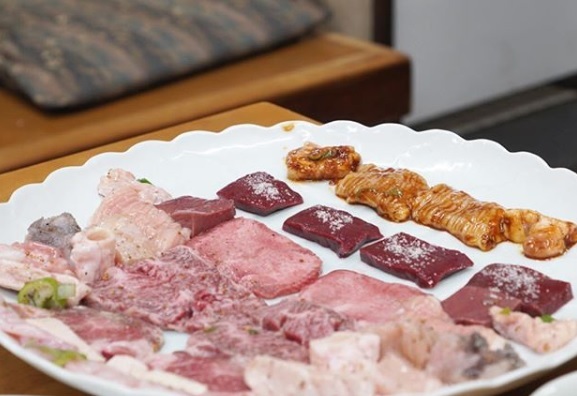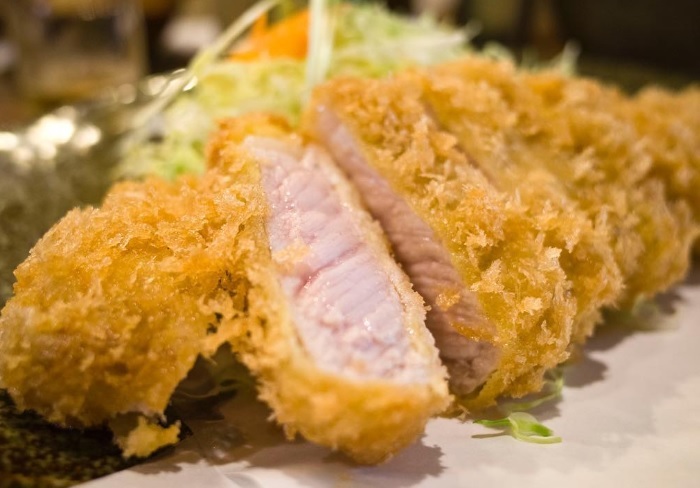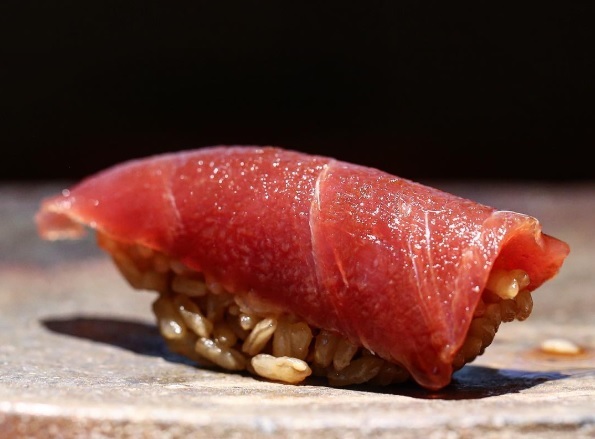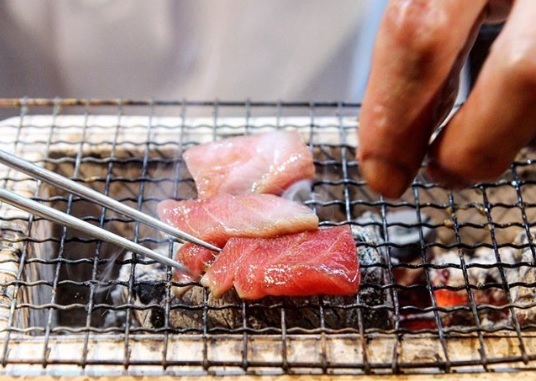A visit to ‘Sushi Watanabe’ ~A tale woven with Sushi~
Sushi Watanabe – A tale woven with Sushi
At night, Yotsuya Araki-cho was filled with excitement.
As it once was a place where gorgeous Geishas went by, the area is packed with numerous restaurants standing in a row.
Bars and diners. serving Chanko(Hot-pot dish), Kushi-yaki and Fugu(Blow fish).
Delicious aroma exhausted from each shop permeates the air, where you can hear the chatter and laughter of the customers, the dim lighting of the shops leaking out to the streets.
For someone who is hopping from one restaurant to another, the area is simply very exciting.
Amongst the numerous shops, stands a Sushi-shop right at the corner of the back alley, where the Shikkui-wall of the building stands out from its surroundings.
The name of the shop is Sushi Watanabe.
The fluttering of the Noren creates a graceful scene, as the setting sun gently shines the snow-white wall of the building.
As I walked into the shop, my eyes met with Masayasu Watanabe, the owner chef.
Watanabe is 43 years old this year, and he looks as if he is one of the rakugo-masters in the TV-show ‘Shoten’. You would want to make him dress in one of those bright colored kimonos.
After learning the basics at Okazaki Tsuruya, a luxurious high-class restaurant in Kyoto, Watanabe then apprenticed at Sushi Hide and Sushidokoro Den, until he finally opened his own shop in 2014.
Even though my last visit was 4 months ago, Watanabe quickly showed me to a seat, saying ‘Welcome. We’ve been looking forward to your visit. Your seat is here, and it is where you were seated on your last visit.’ Splendid sushi masters often possess splendid memory.
Splendid sushi masters often possess splendid memory.
The seats are wide and comfortable, where you can literally stretch your legs and relax.
The Kiso-hinoki wood counter gives no pressure to the customers and the entire restaurant is filled with a comfortable and laid-back atmosphere.
‘Would you like to have some Otsumami dishes in the beginning, followed by Nigiri in the end?’
‘Yes! I’ve come here today to experience exactly that.’
Even though I am the head of the Sushi-shops-should-only-serve-Sushi party, I am particularly in love with Watanabe’s Otsumami dishes, where you can try and compare a variety of menu.
The following is the basic course menu.
1) Seasonal otsumami
2) Comparing tasetes of white-flesh fishes
3) Comparing tastes of blue-gilled fishes
4) Comparing tastes of crustaceous seafood
5) Comparing tastes of clams
6) Comparing tastes of Nimono(Simmered fish)
7) Comparing tastes of Yakimono(Grilled fish)
8) Seasonal Chawan-mushi(Dashi pudding)
Each menu differs in thickness of taste and texture, and since the origins of the fishes are all different, you can find out more about the strong points of each fish type.
The ingredients are cooked with minimal seasoning, so you can enjoy its original natural flavor to the fullest.
This day, I was particularly impressed with their Matsukawa Kalei (flounder fish).
It was a very rare opportunity to be able to taste this fish, for it is very expensive, much like the Hoshi Kalei.
When biting into the freshly vinegar-seasoned flesh, the umami slowly spreads and sinks into your taste buds.
After the spectacular Chawan-mushi with Uruka(salted sweetfish guts), the time is ready for some sushi.
For starters, Kawahagi(filefish).
The chewy texture is just remarkable.
It is secretly served with its liver, leaving a lasting rich taste in your mouth.
It is probably the best starter menu to feel the coming of the autumn season.
Secondly, Sanma (Pacific saury).
It not only tastes of its thick fish-oil, but the deep sweet flavor and umami follows right after.
Apparently, the chef uses mackerel liver as a secret seasoning, basically creating a Kimo-shoyu (soy sauced mixed with fish liver).
When you image barbecued sanma((Pacific saury) liver, you would imagine a slight bitter taste, yet when the fish itself is served fresh, the liver tastes surprisingly sweet and delicious.
However, in order for the liver to be ‘fresh’, the fish has to be served only within hours after its capture.
Even when you keep it in a cool refrigerated environment right after its capture, it only takes half a day for the liver to get bitter.
Therefore, Watanabe exclusively gets his sanma(Pacific saury) from the near-sea.
Watanabe does not narrow his option to rare ingredients but rather he concentrates in the process of getting the best ingredients for well-known menus, aiming to serve the best sushi possible to customers.
Saba(Mackerel), Toro(Fatty tuna), Kohada(Gizzard shad), Sumi-ika(Sumi-squid), Ikura(salmon roe) and Akagai(ark shell)…then appears theUni(Sea Urchin), the special menu of the shop.
It is famous among Sushi maniacs that you can taste and compare a variety of sea urchin at Watanabe, brought from all over Japan.
Normally, the sea urchin is served in separate portions, yet knowing that I was a sushi maniac, Watanabe offered to compare the different types of sea urchin as sushi.
His service-minded craft is also his strong point.
afun-uni from Hokkaido, Shiro-uni from Iwate, Kuro-uni from Hyogo, and Aka-uni from Saga…
Whenever I eat the Uni(Sea urchin) served at Watanabe’s, I am always pleasantly surprised with the extent of how the environment affects the taste of each Uni(Sea urchin).
However, we the customers must remember how we are able to compare the taste of such variety all due to the great efforts made by Watanabe.
Watanabe actually makes business deals with the local fisherman himself to obtain particular types of Uni(Sea urchin).
There were times when he ended up with Uni(Sea urchin) of lesser quality, but he stayed on in touch with them to build mutual trust and confidence.
‘Building trust on a year-long basis with the local fishermen and fish brokers is essential,’ says Watanabe.
Generally, Uni(Sea urchin) is said to be an ingredient that is difficult for the chef to reflect his skill.
Yet the philosophy and knowledge of the chef reflects in the selection of which type of Uni(Sea urchin) to use for each menu.
When you think about it that way, you can say that Uni(Sea urchin) sushi is very much a product of the careful craft of the chef.
After finishing few more sushi – Kuruma-ebi(shrimp), Anago(Anago-eel), Egg-roll and Kanpyo-rolls - I openly praised Watanabe’s work.
Blushing, Watanabe responded with a happy laughter.
Time at Sushi Watanabe is simply very fun and entertaining.
When you meet Watanabe for the first time, you may see him as being a difficult man, yet when you start to get along with him, it would not take long for you to feel so much closer.
Watanabe is dandy and a service-minded .
He is filled with love for the ingredients he uses.
When he sees that the customer is also a Sushi lover, he would share his endless share of knowledge.
How to determine the best Saba(Mackerel) from its looks, figuring out the best fishing areas from its history, the difference of how Uni(Sea urchin) is treated among different venders, the mechanism of how the best-season of each fish changes from time to time…
You would realize your curiosity to be satisfied along with your stomach.
If you are one of the knowledge craving types of sushi maniacs, you would get along very well with Watanabe and you would fall even more in love with this shop.
Of course, he is not just a brainy sushi chef.
All of the dishes are seasoned gently in a Washoku(Japanese cuisine) fashion, much like his Washoku(Japanese cuisine)background.
Watanabe magically uses the different elements – ‘Hashiri(fish that have just started coming into the market)’’Shun(fish that are right in season at the time)’’Nagori( fish that are on the way out of season)’, producing a perfectly designed course meal.
As a chef with roots in Washoku(Japanese cuisine), Watanabe is particular about having the authenticity of a sushi shop.
‘I believe sushi shops are supposed to be more open and welcoming, a place where you can spontaneously stop by. Scheduling and having the customers come and go in a cycle basis might be easier for the owner to manage. Yet that is not the essence of a sushi shop. Serving the customers the best meal possible while enjoying the conversation, is supposed to be the essence. I am a sushi chef with a Washoku(Japanese cuisine) background and I pride myself in my origins. I have kept this as my motto ever since I started my own place.’
You can feel Watanabe’s passion right from his words, and you would also know it just as you take a seat at his shop.
Honestly speaking, there are times when I feel that Watanabe’s sushi is still improving yet I believe that his craft would become even better in the near future.
‘Our job as craftsmen is to continually repeat the same craft day after day. On the other hand, I always tell myself that what I am working on right now is not ‘the entire picture’. Rather, I remind myself that there are always new alternative ways. Of course, often times I experience a lot of failure… lol’
Most commonly, when you reach the age of 40 you would tend to think in the present, and strive to maintain the status quo. This man is different, where he tries to destroy what he has built so far with his endless curiosity. Obviously not something anyone can do.
I was fully content when leaving this shop.
There is always a story to be told after visiting Watanabe’s.
Wide range of knowledge and original sense of beauty, blended with the timely seasonality, composes a unique and original story for every visit.
Just like one of those sleepless nights when you become buried in those novels just to figure out ‘what happens next,’ your curiosity would never be fulfilled at this place.
Our ancestors have utilized all five senses to feel and realize the changing of the seasons.
Enjoying the different tastes and aspects of nature that differs among each season, is the definition of an intelligent lifestyle of this country.
Watanabe is a solid storyteller of his world.
When you weave together a story with sushi, the ingredients are your words.
You need to know a variety of words and letters to weave together an elegant masterpiece.
I am sure that Watanabe would produce the perfect story for each season.
Writer:Shuto Saito
Blogger. Sushi geek.
By coincidence, he became fascinated by the world of Edomae-style Sushi.
Where exactly is the best sushi restaurant in Japan?"
In 2016, to answer that question, he decided to embark on a quest to discover the "No.1 Sushi Restaurant".
He traveled everywhere, dining at one famous sushi restaurant after another, and his restaurant reviews - combining personal observations with his actual experiences - caused a sensation among Japanese foodies.
He fell in love with some particular restaurants along the way, and still visits to enjoy their lip-smacking sushi.
http://blog.livedoor.jp/shuto_saito/
https://note.mu/shuto_saito
Register account first.
Register










Comments 2
2
Leo Saito
chief editor, TokyoTableTripIn the final round of the series, we are going to introduce "Sushi Watanabe"
This time, we will be taking you deep into this shop that all the sushi maniacs love so much.
Definitely give it a shot!
guest
I can only find a Watanabe in Ginza -- is it the same one?